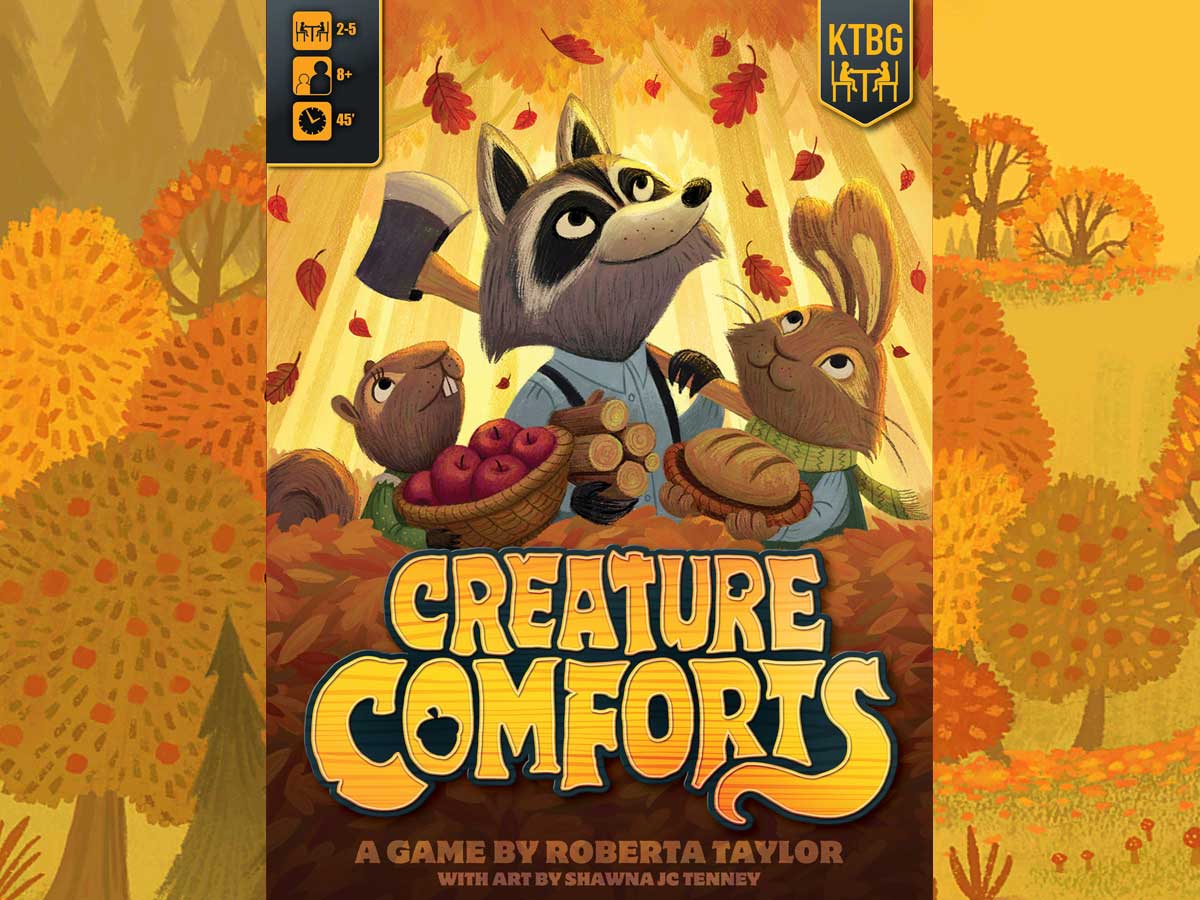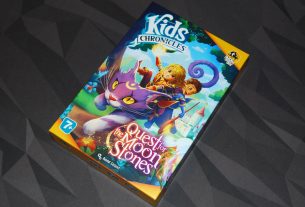Get ready for winter! Gather resources and make your den as cozy as possible by filling it with Creature Comforts.
What Is Creature Comforts?
Creature Comforts is a worker-placement game for 1 to 5 players, ages 8 and up, and takes about 45 minutes to play. It’s currently seeking funding on Kickstarter, with a pledge level of $49 CAD (about $38 USD) for a copy of the retail version, or $59 CAD (about $46 USD) for the Kickstarter edition, which includes custom wooden pawns instead of cardboard as well as GameTrayz for storage. I will note that often when you see a game rated as “8+” it means it’s a pretty simple game, but this one has some meat on its bones; I’d also guess the 45-minute estimate is for experienced players but expect it to be quite a bit longer than that when everyone is learning.
Creature Comforts was designed by Roberta Taylor and published by Kids Table Board Gaming, with illustrations by Shawna JC Tenney.
New to Kickstarter? Check out our crowdfunding primer.
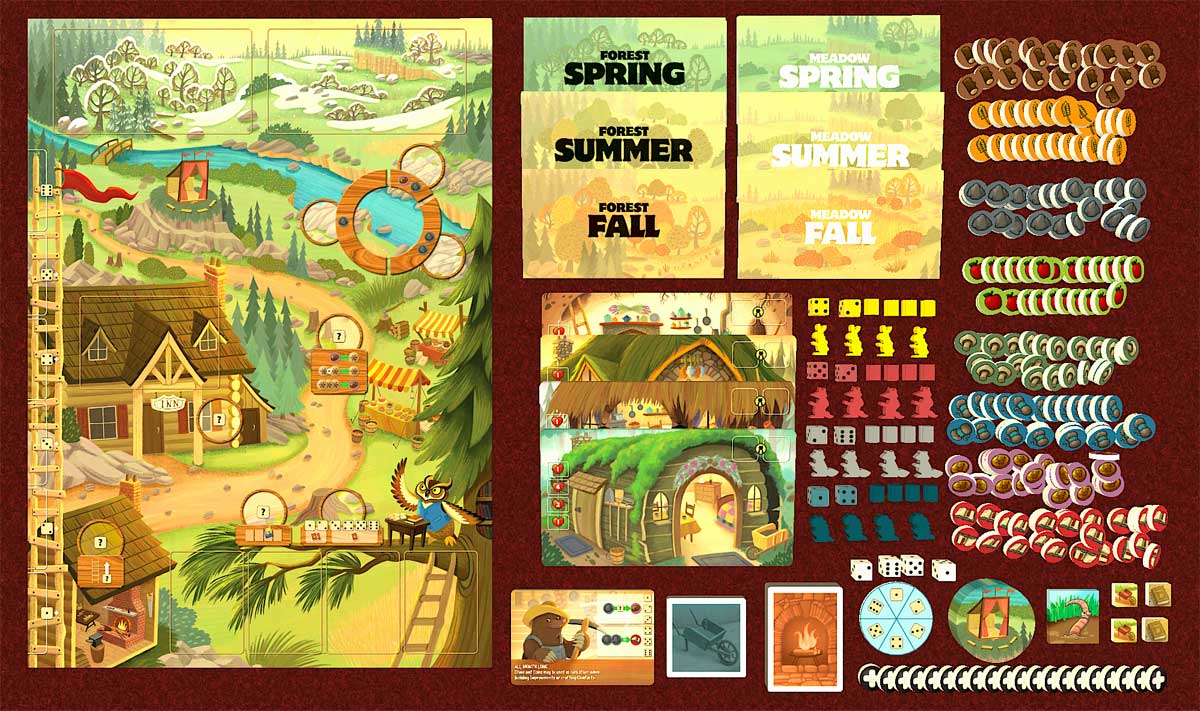
Creature Comforts Components
Note: My review is based on playing in Tabletop Simulator, so it is subject to change and may not reflect final component quality. The Tabletop Simulator version only had components for 4 players, but the finished game will go up to 5 players. The exact number of components may also increase based on stretch goals, so my list is current as of this writing.
Here’s what will come in the game:
- Game board
- 16 Valley cards (8 Forest, 8 Meadow)
- 5 Home boards
- 12 Traveler cards
- 28 Improvement cards
- 57 Comfort cards
- 14 Dice (2 colored dice per player, plus 4 white dice)
- 20 Workers (4 per player)
- 20 Cottages (4 per player)
- 154 Resource tokens:
- 20 Wood
- 18 Grain
- 20 Stone
- 20 Fruit
- 18 Mushrooms
- 18 Yarn
- 20 Coins
- 20 Stories
- River Dial tile
- Hilltop tile
- Worm tile
- 4 Improvement tiles (Wheelbarrows and Almanacs)
- 20 Lesson Learned tokens
The retail edition and the Kickstarter edition will have somewhat different components, though you can get either one through the Kickstarter campaign. For instance, the Kickstarter edition has wooden resource tokens instead of cardboard tokens (like the ones seen in the image above), and will also have custom meeples and cottages instead of standard pawns and houses. The Kickstarter edition will also include custom GameTrayz for storage.

I’ve only seen the game on screen, but the artwork by Shawna JC Tenney just gives a wonderful sense of warmth that goes perfectly with the theme of the game.

Crackling fireplaces, rocking chairs, a bubbling pot of stew—it really makes you want to curl up in a bundle with a hot drink. Each of the home boards has its own artwork—you don’t even really store a lot on your boards other than the two dice and four cottages, but it helps create the atmosphere.

Another lovely touch is the artwork on the valley cards, which change each round. The cards have locations where you can go to get resources, and represent spring, summer, and fall. (Winter is printed on the board itself, signaling the end of the game.) I love the fact that the illustrations reflect the changing of the seasons as you go.

Here’s a look at the main game board, just to give you one more look at Tenney’s artwork. The circle frames are places where you can place your workers, and there are also several areas where cards will be placed on the board and along the left side. It all looks like something from a picture book, and is really delightful.
You’ll see more illustrations on the cards below.
How to Play Creature Comforts
You can download a copy of the rulebook here.
The Goal
The goal of the game is to score the most points by crafting comforts and improvements with your resources.
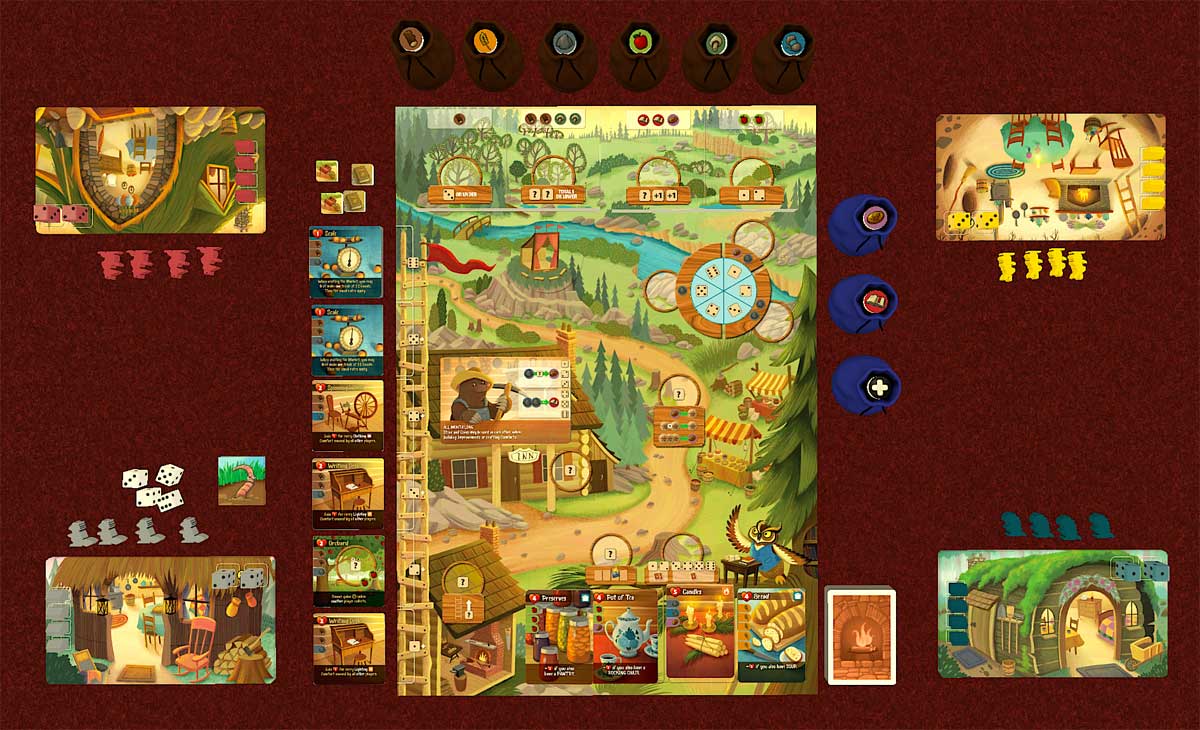
Setup
Place the game board in the center. Set up the valley cards: for the forest and the meadow, organize them so the stacks have fall cards on the bottom, then summer, then spring, randomized within each season. (For a shorter game, you can remove a spring and summer card from both stacks, making the game 6 rounds instead of 8.) Place the hilltop tile on the hill, and the river dial in the ring in the river, turned in a random orientation. Shuffle the traveler cards and place them face-up on the Inn.
Shuffle the improvement cards and turn 4 of them face-up along the bottom of the board. Shuffle the Improvement cards and reveal five of them face-up along the ladder on the left side of the board. Place the deck in the top slot, and flip over the top card so it’s face-up. Set the piles of resources nearby.
Give each player a home board, 4 workers, 4 cottages, and 2 colored dice. Place the cottages and dice on the spaces of the home board. Draw 3 comfort cards from the deck; choose 2 to keep and discard the third face-up into a common discard pile. Depending on the number of players, some players may receive a coin.
Choose a random player to be first, and give them the worm token and the four village dice.
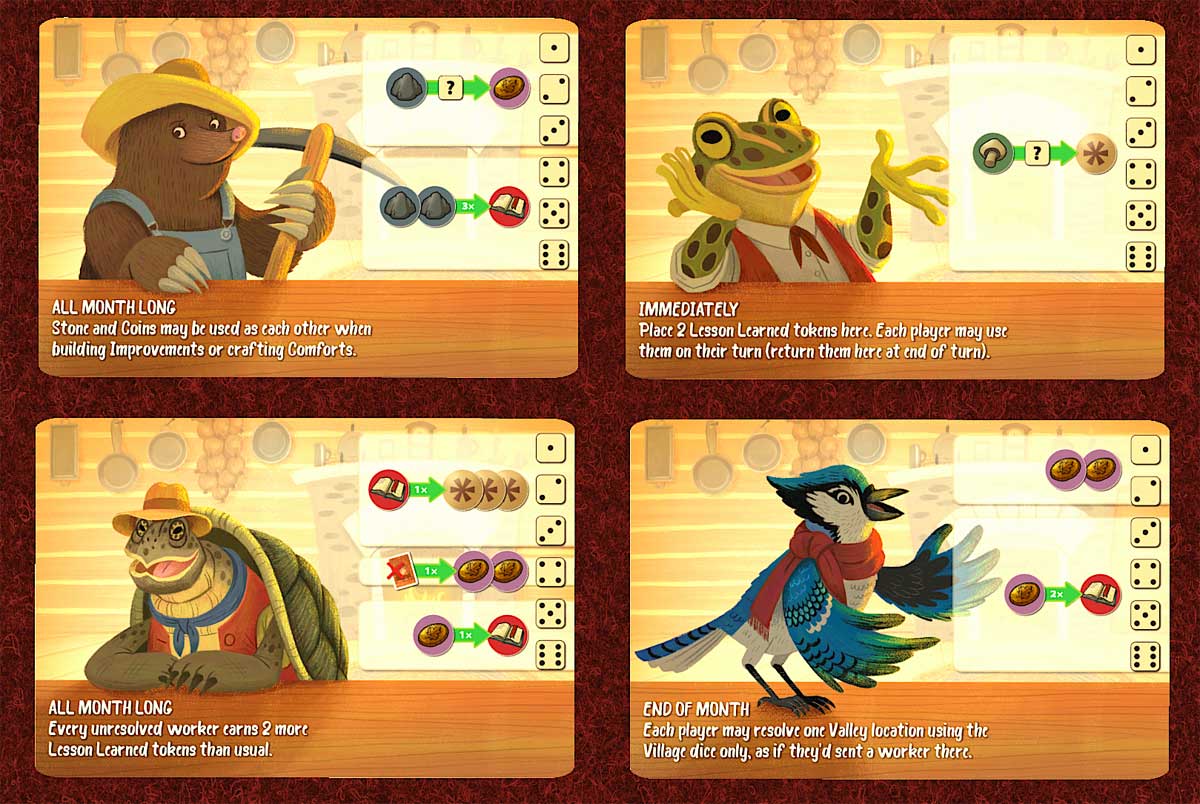
Gameplay
Each round consists of the following steps: Family Dice, Worker Placement, Village Dice, Player Turns, and Upkeep. At the beginning of the round, check the traveler in the inn—if it has an immediate effect, do that now.
Family Dice: Each player rolls their family dice and places them onto their home board.
Worker Placement: Simultaneously, everyone gets to place their workers onto the game board. You may not place two of your own workers in the same circle, but there is no limit to the number of players who can occupy the same circle.
Village Dice: Once everyone is satisfied with their placements, the first player rolls all the village dice and places them on the hilltop.
Player Turns: Here’s where the bulk of the action happens. In turn order, players will activate their workers using their own dice and the village dice. Each player will resolve all of their workers before the next player takes a turn.
In order to use a space, you must assign dice to a worker—place the required dice in the circle, and then retrieve your worker and take the action. Before you take your turn, place your family dice on the hilltop as well. Here are what the various spaces on the board do.

The valley (forest and meadow) and the river let you collect various resources. For the valley, you’ll need the number of dice shown below the circle matching the criteria: two dice with a certain total, dice with specific values, three dice in sequence, and so on. The requirements and the resources will change each round. At the river, you can get stone and coins if you have the right value die.

At the inn, there’s a traveler card (which changes each round) that has some actions you can take, depending on the die value. The traveler also provides some sort of effect—either immediate at the beginning of the round, an ongoing effect for the round, or an effect at the end of the round. The market can use any value of die, and lets you make as many trades as you want: 1 coin for any resource, 2 of the same resource for 1 of a resource, or 3 resources for a coin. (Note that coins and stories are not regular resources for the purposes of these trades.)

At the bottom of the board, there’s the workshop and the owl’s nest. The workshop lets you build improvements: you must have the required resources to build one of the displayed improvements; the die you use indicates how high up the ladder you can go to claim an improvement. When you build an improvement, set it near your home board and place your lowest cottage onto the improvement card (revealing a point value). The owl’s nest has two spaces: the one on the left lets you take one face-up comfort card (using any die value) and then replace it from the deck; the one on the right will give you one or two cards from the deck based on the die value. Comfort cards go into your hand.
You may activate your workers in any order. Once you’ve activated as many as you want to, you retrieve any remaining workers that weren’t activated—for each worker that you don’t use (either because you don’t have the correct dice or you choose not to), you get a lesson learned token from the supply. These tokens may be used to add or subtract 1 from your family dice when activating workers.
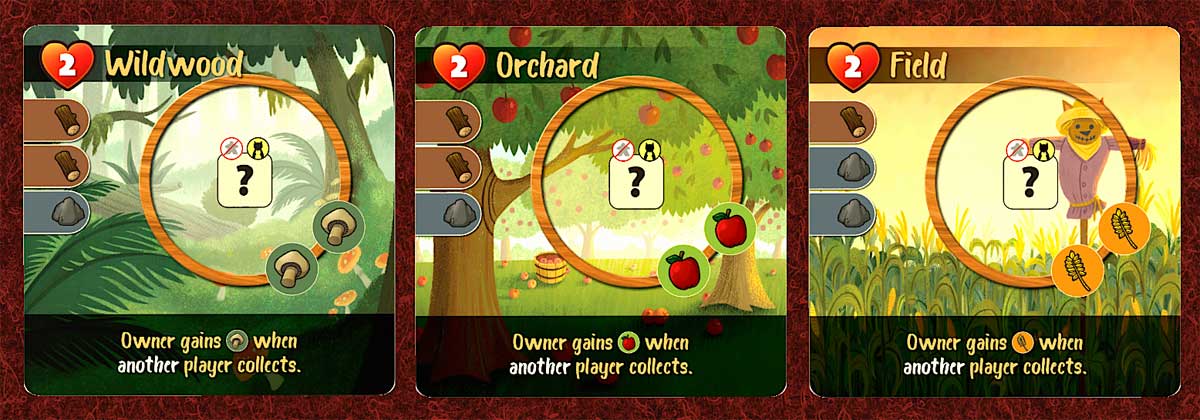
Some of the improvement cards have circles on them as well, and should be placed near the valley when built—if any of these are available, you may send an unused family die to collect resources. (It does not require a worker.) The owner gets a bonus if somebody else uses a location they built.

At the end of your turn, you may craft any number of comforts from your hand by spending the required resources. Comforts are placed face-up in front of you.
After you’ve finished your turn, place the village dice back on the hilltop (without changing their values) and take your family dice back to your board, and then the next player takes their turn.
Upkeep: First, if the traveler at the inn has an “end of month” effect, trigger that now. Then discard the traveler, as well as the top forest and valley card. Rotate the river dial one step clockwise. Discard the leftmost comfort in the owl’s nest and slide everything to the left and draw a new card for the empty slot. Pass the worm token clockwise. All players must discard down to 3 comfort cards in their hand.
Game End
The game ends at the end of the 8th round, when the forest and valley cards run out. All players may craft any number of comforts in their hand if they have enough resources. Then, add up the scores!
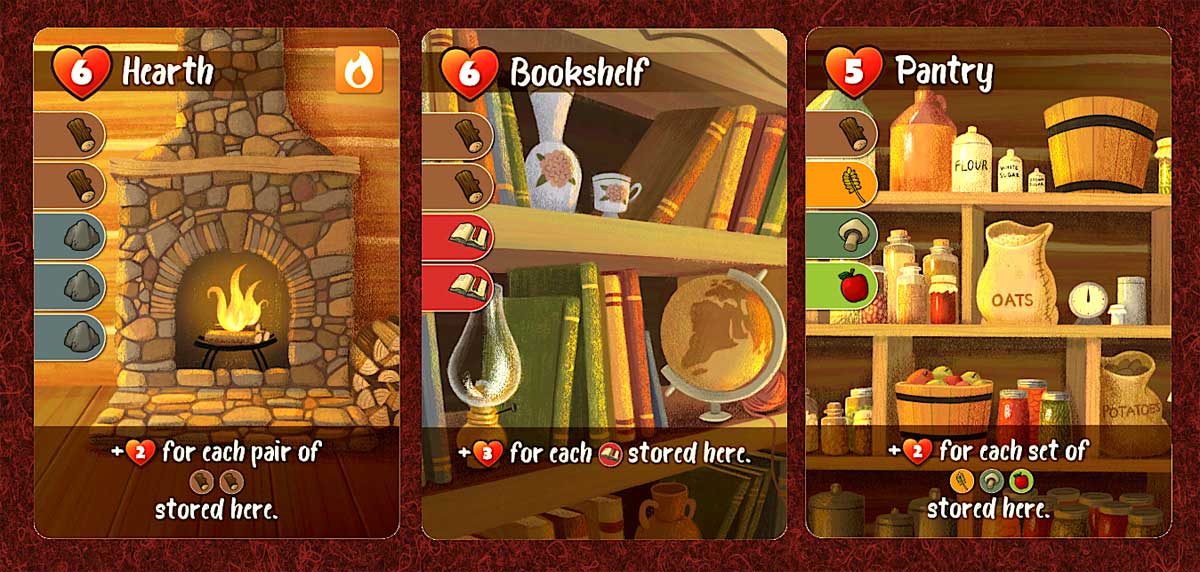
If a card gives bonus points for storing resources on it, you may move resources to it now. (Note that these will not score as leftover resources later.)

Each improvement card you built has its own score, plus you also get the points revealed on your home board when you removed the cottage. Also. some improvements may give you bonus points if your rivals crafted comforts from specific categories.
Finally, you score points for your leftover (not stored) resources: stories are worth 2 points each, coins are worth 2 point each, and regular resources are worth 1 point per set of 3. The player with the highest score wins—and ties mean that you win together, which is “even better” according to the rules.

Solo Rules
Solo play works like the regular game, though you remove the Lynx traveler, and the improvements that offer bonuses will now count your own comforts instead of other players’. You check your score against the scoring chart to see how you fared, from “Should Have Hibernated” to “A True Creature of Comfort.”
Why You Should Play Creature Comforts
Creature Comforts adds some new twists to the worker-placement genre. At first I referred to it as a “dice worker-placement” game, but that’s not exactly the case, either. There are games where your workers are dice, and the values of the dice may determine where you can use the workers, or whether they can bump another player out of a space. Creature Comforts is a little more like gambling: the dice aren’t workers themselves, but are spent to enable the workers. You can put your workers anywhere (even with other players), but you may not know for sure whether you’ll actually be able to use the space until after you’ve committed.
Each turn, you know you’ll have access to 6 dice to spend, and you know the values of 2 of them. Lesson learned tokens and some of the improvements may allow you to manipulate your dice a little—but usually only your own dice. You might want those 2 wood in the forest, but can you count on having a 5 and a 6 when the village dice are rolled, or should you settle for a single wood because you already have a 4? If you’re willing to take back one of your workers with a lesson learned token, you can hedge your bets a little and go both places—at the cost of performing another action somewhere else this round.
In many worker-placement games, there can be a fight over who gets to go where, if each space is limited. That’s not usually the case in Creature Comforts: just because somebody went to the meadow and collected some wheat and mushrooms doesn’t mean you can’t get the same thing, as long as you have the dice for it. The only two spots that can lead to conflict are the workshop and the owl’s nest, because one player might take a card that somebody else wanted—but these are simply resolved by which player gets to go first. However, if the player ahead of you doesn’t get the right dice values, you still have a chance.

Deciding what to craft—both improvements and comforts—is largely what drives the rest of your actions, because that’s primarily how you’ll score points. The two cards you start with may point you in a direction. Some improvements give you ongoing abilities, and the sooner you build one, the more benefit you’ll get out of them. Building a location improvement may earn you some bonus resources if other players go visit it. Aside from the point value of the improvements themselves, you also earn the points on your home board for each improvement built, with the biggest score bump coming from your third improvement. And you’re limited to building four improvements, so you want to make the most of them, too.
There are many comforts that give bonuses based on what else you have, with some that chain together. Stew gets 2 bonus points if you have Bread, which gets 2 bonus points if you have soup. But if you’ve been cooking up a storm, it makes the herb garden improvement (giving 1 bonus point for every food item made by other players) pretty attractive to everyone else. The fact that you can only hold 3 comfort cards in your hand at the end of the turn means that you can’t hoard that many things and just craft them at the end, so other players will know what sorts of bonuses they might get from your comforts.
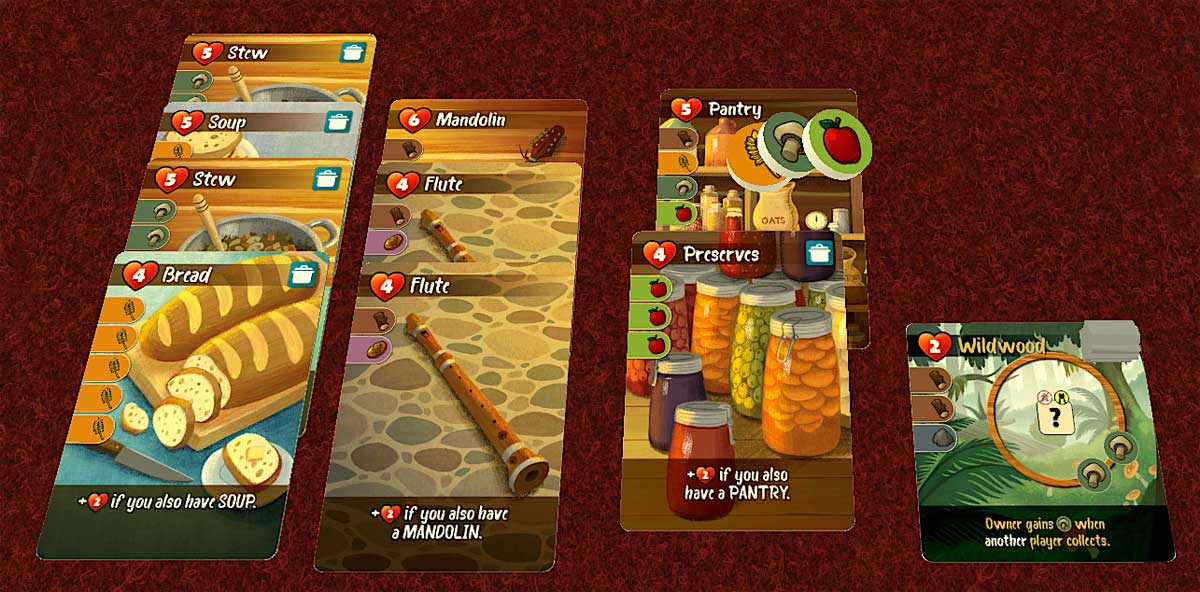
I like that, thematically, this isn’t really a competition. The herb garden is worth more because everyone making food will want to come get herbs from you. The spinning wheel scores bonus points, presumably, your neighbors come and buy thread or yarn to make their clothing. Sure, there’s a winner to the game, but you win because you made a cozy, friendly home. Now, that’s not to say this game can’t be competitive! Just listen to the cheers or groans when the village dice are rolled and you know players are invested in the outcome.
I mentioned at the outset that the game is a little more complex than I’d expected at first, based on its age rating, the cover art, and the publisher: Kids Table Board Gaming has published games like Haunt the House and Problem Picnic, with a focus on family-friendly games that adults can play with their kids, and Wreck Raiders got a 10+ rating. Creature Comforts felt a little closer to the latter to me, just in terms of gameplay and game length, and the fact that it can require some long-term planning if you’re trying to get some of the combos and bonus points. I think it’s a game that many adults will enjoy playing, with or without kids. (Since I’ve only been able to play it on Tabletop Simulator so far, I haven’t gotten a chance to try it out with my own kids yet, alas.)
Creature Comforts is a warm, cheerful game—maybe exactly the sort of thing we need after a brutal year. Of course, you’ll have to wait a bit for it, but hopefully when next winter rolls around you’ll be able to invite your friends over, serve some mulled cider and wrap up in a cozy quilt, and play this game.
For more information or to make a pledge, visit the Creature Comforts Kickstarter page!
Click here to see all our tabletop game reviews.
![]() To subscribe to GeekDad’s tabletop gaming coverage, please copy this link and add it to your RSS reader.
To subscribe to GeekDad’s tabletop gaming coverage, please copy this link and add it to your RSS reader.
Disclosure: GeekDad received a copy of this game for review purposes.
